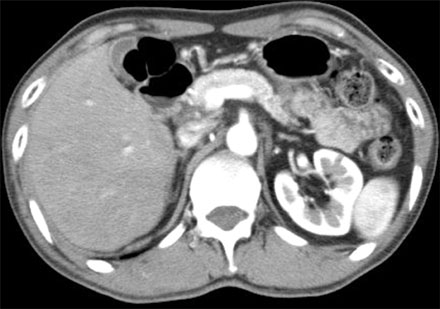Tuberc Respir Dis.
2008 May;64(5):383-386. 10.4046/trd.2008.64.5.383.
A Case of Bronchiectasis with High Serum CA19-9
- Affiliations
-
- 1Department of Internal Medicine, Dong-A University College of Medicine, Busan, Korea.
- 2Department of Pathology, Dong-A University College of Medicine, Busan, Korea.
- 3Department of Radiology, Dong-A University College of Medicine, Busan, Korea.
- 4Department of Thoracic and Cardiovascular Surgery, Dong-A University College of Medicine, Busan, Korea.
- KMID: 1478196
- DOI: http://doi.org/10.4046/trd.2008.64.5.383
Abstract
- An elevated serum CA19-9 level is an indication of pancreatic and biliary tract cancer. However, it has recently become known that nonmalignant gastrointestinal diseases and a variety of nonmalignant respiratory diseases, such as idiopathic interstial pneumonia, collagen vascular disease associated lung diseases, diffuse panbronchiolitis and bronchiectasis, can also show an elevated serum CA19-9 level. We recently encountered a case of bronchiectasis with persistently elevated serum CA19-9, but without any evidence of malignant disease in endoscopic retrograde pancreatocholangiography, abdominal computed tomography, and positron emission tomography. After serial follow-up of 3 years and 10 months, there was still no evidence of cancer. It is believed that the elevated serum CA19-9 level was due to bronchiectasis. An elevated serum CA19-9 level should be interpreted carefully with the patients' clinical condition.
Keyword
MeSH Terms
Figure
Reference
-
1. Plebani M, Basso D, Panozzo MP, Fogar P, Del Favero G, Naccarato R. Tumor markers in the diagnosis, monitoring and therapy of pancreatic cancer: state of the art. Int J Biol Markers. 1995. 10:189–199.2. Levy C, Lymp J, Angulo P, Gores GJ, Larusso N, Lindor K. The value of serum CA19-9 in predicting cholangiocarcinomas in patients with primary sclerosing cholangitis. Dig Dis Sci. 2005. 50:1734–1740.3. Shimizu Y, Hamada T, Tanaka Y, Sasaki A, Nemoto T. Colonization of CA19-9 and KL-6 to epithelial cells in dilated bronchioles in a patient with idiopathic pulmonary fibrosis complicated by diffuse alveolar damage. Respirology. 2002. 7:281–284.4. Mukae H, Hirota M, Kohno S, Komori K, Fukushima K, Hiratani K, et al. Elevation of tumor-associated carbohydrate antigens in patients with diffuse panbronchiolitis. Am Rev Respir Dis. 1993. 148:744–751.5. Ishiura Y, Fujimura M, Minami S, Ueda A, Iwata M, Watanabe K, et al. Increased CA19-9 level in serum and bronchoalveolar lavage fluid from a patient with pulmonary tuberculosis. Nihon Kyobu Shikkan Gakkai Zasshi. 1996. 34:477–481.6. Shimizu Y, Hamada T, Tanaka Y, Sasaki A, Nemoto T. Colocalization of CA19-9 and KL-6 to epithelial cells in dilated bronchioles in a patient with idiopathic pulmonary fibrosis complicated by diffuse laveolar damage. Respirology. 2002. 7:281–284.7. Kodama T, Satoh H, Ishikawa H, Ohtsuka M. Serum levels of CA19-9 in patients with nonmalignant respiratory diseases. J Clin Lab Anal. 2007. 21:103–106.
- Full Text Links
- Actions
-
Cited
- CITED
-
- Close
- Share
- Similar articles
-
- Intralobar Pulmonary Sequestration Showing Increased Serum CA19-9
- The Correlation of Serum Level of Tumor Marker CA125 and CA19-9 and Severity of Endometriosis
- The Diagnostic Significance of CA72-4 in Cancer Patient
- Effect of Biliary Drainage on the Diagnostic Values of Serum and Bile CEA and CA19-9 in Patient swith Obstructive Jaundice and/or Acute Cholangitis
- The clinical significance of serum CA125 and CA19-9 levels in endometriosis



